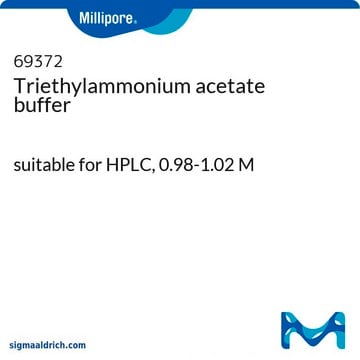98479
Tetrabutylammonium bisulfate solution
suitable for ion pair chromatography, LiChropur™, concentrate, ampule
Synonym(s):
Tetrabutylammonium hydrogen sulfate solution
Sign Into View Organizational & Contract Pricing
All Photos(1)
About This Item
Linear Formula:
(CH3CH2CH2CH2)4N(HSO4)
CAS Number:
Molecular Weight:
339.53
Beilstein:
3599663
EC Number:
MDL number:
UNSPSC Code:
12000000
PubChem Substance ID:
NACRES:
NB.21
Recommended Products
description
cationic
Quality Level
form
solution
quality
LiChropur™
ampule
packaging
ampule of 25 mL
technique(s)
ion pair chromatography: suitable
SMILES string
OS([O-])(=O)=O.CCCC[N+](CCCC)(CCCC)CCCC
InChI
1S/C16H36N.H2O4S/c1-5-9-13-17(14-10-6-2,15-11-7-3)16-12-8-4;1-5(2,3)4/h5-16H2,1-4H3;(H2,1,2,3,4)/q+1;/p-1
InChI key
SHFJWMWCIHQNCP-UHFFFAOYSA-M
General description
Concentrate for 6x1 L ready-to-use solution. Dilute contents of one ampule (~0.3 M) to 1 L with HPLC grade water to obtain a 0.005 M eluent solution.
Legal Information
LiChropur is a trademark of Merck KGaA, Darmstadt, Germany
Signal Word
Danger
Hazard Statements
Precautionary Statements
Hazard Classifications
Eye Dam. 1 - Skin Corr. 1
Storage Class Code
8A - Combustible corrosive hazardous materials
WGK
WGK 2
Flash Point(F)
Not applicable
Flash Point(C)
Not applicable
Personal Protective Equipment
dust mask type N95 (US), Eyeshields, Gloves
Choose from one of the most recent versions:
Already Own This Product?
Find documentation for the products that you have recently purchased in the Document Library.
Customers Also Viewed
K M Frankowski et al.
Journal of dairy science, 97(9), 5356-5370 (2014-07-16)
Many food companies are trying to limit the amount of sodium in their products. Permeate, the liquid remaining after whey or milk is ultrafiltered, has been suggested as a salt substitute. The objective of this study was to determine the
Erbo Shi et al.
Organic letters, 14(13), 3384-3387 (2012-06-27)
A metal-free C-H oxidation for the construction of allylic esters has been developed. The use of a commercially available and inexpensive catalyst and oxidant, and readily available starting materials, coupled with the operational simplicity of the reaction, renders the methodology
Fabio Galeotti et al.
Journal of chromatography. A, 1284, 141-147 (2013-03-05)
In this study, by using tetrabutylammonium bisulfate as ion-pairing reagent, we were able to separate all the main heparin/heparan sulfate disaccharides generated by the action of heparinases along with the main Hep tetrasaccharide possessing a 3-O-sulfate group on the sulfoglucosamine
R Bryan Sears et al.
Journal of inorganic biochemistry, 121, 77-87 (2013-01-29)
The complex cis-[Ru(phpy)(phen)(CH3CN)2](+) (phpy=2-phenylpyridine, phen=1,10-phenanthroline) was investigated as a potential photodynamic therapy (PDT) agent. This complex presents desirable photochemical characteristics including a low energy absorption tail extending into the PDT window (600-850nm) and photoinduced exchange of the CH3CN ligands, generating
Morteza Moradi et al.
The Analyst, 137(15), 3549-3557 (2012-06-27)
Hollow fiber-based liquid phase microextraction (HF-LPME) using conventional solvents is limited by their relative instability and high volatility. The use of supramolecular solvents as a liquid membrane phase could overcome these inconveniences due to their negligible vapour pressure and high
Our team of scientists has experience in all areas of research including Life Science, Material Science, Chemical Synthesis, Chromatography, Analytical and many others.
Contact Technical Service






